Obtaining a Regulation Checkers Set
Please note: information on this page changes rapidly, and quickly goes out of date. We'll make changes and updates as time permits. Our thanks to everyone who has sent in additions and corrections.
1. About Checkers Sets.
A regulation checkers set, as defined by the American Checker Federation, is anything but the old red and black sets we grew up with as kids.
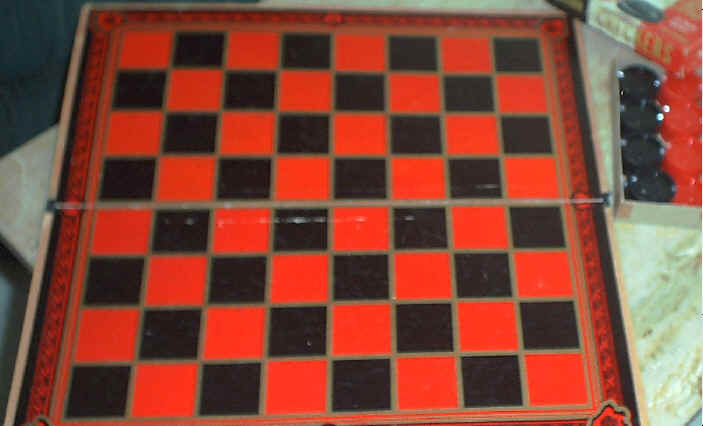
This old favorite, featuring very light and insubstantial interlocking black and red plastic checkers (about 1 1/4" diameter and 1/4" thick), was played on a black and red squared board with a playing area about 12" on a side. Thin yellow lines separate the squares. This is what we always thought of as "real checkers" even though the black pieces blended in with the black squares with so little contrast that we at times overlooked a move (although I suppose we overlooked many moves).
This is not a regulation checkers set nor in any sense checkers as the game can really be. Granted, it was fun. But learning about the depth and splendor of this game is for me, as an adult, a whole new and wonderful experience.
So, I wanted a "real" checkers set, for which the American Checker Federation has a very clear definition.
The board is to have green and buff squares, with play taking place on the green squares. The squares are to be 2" on a side (making the playing surface 16" on a side). The pieces are to be round and turned, colored red and white, made of solid material, with a diameter of 1 1/4 - 1 1/2 ". (Material and other detail is not specified but generally taken to be smooth and ungrooved with no designs or embellishments. Thickness is not specified other than that the pieces are to be substantially wider than thick.)
The red and white pieces make a nice contrast on the green and buff squares; the solid pieces would have a nice heft and feel, unlike the very cheap plastic pieces commonly found; and the overall larger board size and possibly larger piece size lends an expansive air. (This is something like my early tournament chess experiences with tournament equipment, compared to the small sets I had at home.)
2. Initial Efforts to Buy a "Real" Set
So, I thought, I'll order a regulation checkers set and enjoy checkers in this new way.
I checked where I always check first: the Internet. I couldn't find one. I e-mailed the American Checker Federation itself. I got back a very quick response saying they no longer knew of a source and perhaps I should search on the Internet!
I wrote to Mr. James Loy, who is a real checkers luminary and maintains one of the finest checkers web sites to be found ( http://www.jimloy.com/checkers/checkers.htm) . Mr. Loy was kind enough to respond, saying he too is looking for the same thing; that at the last national tournament he had asked around and failed to find a ready source; and would I let him know if I succeeded? Mr. Loy did point out that backgammon pieces are often available in red and white and would be a perfectly adequate substitute, but he hadn't seen them in a while in toy stores and elsewhere.
Back to the Internet. This was becoming a tough problem.
I will spare you the details of how many web sites I visited, how many e-mails I sent, and the replies I got. (Except for these: A large and famous New York chess shop said that their source of red and white checkers had also dried up. A seller of backgammon pieces in Denmark, who seemed to have the exact thing, was sold out of all his red pieces for a rather long time. Fortunately these are no longer out of stock; more below.)
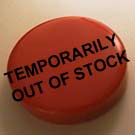
But I am not easily discouraged, and in the end, I came up with some possibilities. Yes, you can buy regulation and near-regulation equipment if you look hard and have patience. Perhaps I can save you a lot of trouble by listing what I've found.
3. Buying via the Internet or Mail-Order.
Internet purchasing is my favorite method; it's fast and convenient. Mail order is a bit slower but still a good option.
3.1 Complete Checker Sets
Let's hit the bottom line and look at full sets before we look at buying pieces and boards separately.
I have only found two options here, both of them mail order.
3.1.1 Don Goodwin
I learned about Don Goodwin from a correspondent who buys supplies for his checkers club from Don. Don unfortunately passed away after a serious illness, but his estate continues to run the business, although for how much longer I cannot say. I would not count on this as a long-term souce of supply.
Don Goodwin has an enormous catalog of checkers books, and included in that catalog is some equipment. Don offers a green and light yellow folding screened board for $16, and a "regulation" board for $16. Although I have not seen these boards, one correspondent describes the folding board as follows:
"Appear(s) to be made from heavy cardboard, covered in thin green vinyl
or coated paper, and with alternate buff squares painted/stenciled on."
Don seems to be recognized as a prime source of regulation equipment.
He also offers an assortment of checkers in various sizes of red and white at $20 or so, depending on size. They are listed as "Catalin" in the catalog. This would indeed represent quite a bargain on a very hard to find item, if they are truly Catalins, which I think unlikely; my best guess is that they are solid color Crisloids (as described in a later section).
I have not ordered sets from Don as yet, but by all accounts they are quite nice.
You can reach Don's estate at 16 Romac Drive, Toronto, Ontario, Canada M1C 4V6; the phone number is 1-416-287-9616, and the email address is dgoodw961@rogers.com. Write before you buy, and make sure you have the latest prices and are ordering the correct item.
3.1.2 The International Checker Hall of Fame
The International Checker Hall of Fame in Petal, Mississippi, sells simple near-regulation checker sets for a very low price; in fact this is the best deal you are going to find. A plastic board and plastic red and white pieces sells for just $5.00 including domestic shipping. Orders of ten sets or more are just $4.00 per set, and would be a really good option for schools, clubs, or large tournaments. The boards are numbered, making them ever so slightly off-regulation, but still quite usable for club and tournament play.
I have ordered a few of these (as of August 27, 2005) and will report further when received.
You can reach the ICHF by email at ichfcheckers@aol.com or by mail at ICHF, P.O. Box 365, Petal, MS 39465. It is possible that the ICHF may close, so delay is not advised.
3.2 Checker Pieces
Let's now look at pieces alone, with the idea that you'll get your board elsewhere.. There are a number of options for fully regulation, and near-enough regulation pieces.
If you want red and white plastic pieces of the insubstantial nature which is found in toy sets everywhere, in red and black, I did find a wholesaler who will sell them in lots of 1000 per color, with a minimum $100 order. If you need 83 sets or want to retail red and white checkers sets this may be your option: check out www.gameparts.net and you'll find more details. Dividing out you get a cost of under well under $2.00 per set of red and white pieces.
(The company is sometimes off-line, but here is their contact info: Phone: 914-593-0403 Fax: 914-593-0405 Email: gameparts@aol.com. Game Parts Inc. 6 Westchester Plaza Elmsford, NY 10523. )
This actually is not so bad but I wanted something with more heft and feel than lightweight plastic (embossed with a crown on one side, a star on the other, and with milled interlocking edges, and therefore not quite regulation).
So I came up with a few options. Your Move Chess and Games has these:

which are actually backgammon pieces sold in groups of 15 red and 15 white (if you buy four sets, you have enough for five checkers sets). They do have some concentric circles and so are not really plain plastic. These come in 1 1/4" diameter and look fairly substantial. They are also not especially expensive (about $15 a set). The concentric circle grooving, though, disqualifies these as strictly regulation.
Your Move Chess and Games also has "Crisloid" backgammon pieces in larger sizes, such as 1 1/2 " :
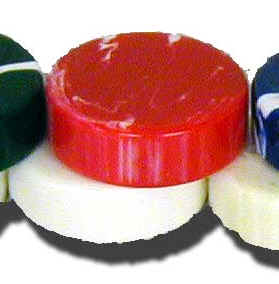
These are quite close to the "exact" thing. The red pieces are marbelized. This is perhaps not a problem, but see the discussion below; and the general feeling seems to be that the swirls are enough to make these short of regulation standard; in any event, solid color pieces have now become at least somewhat available; see below.
Look at the cover photo of Robert Pike's "Play Winning Checkers" and you'll see something similar:
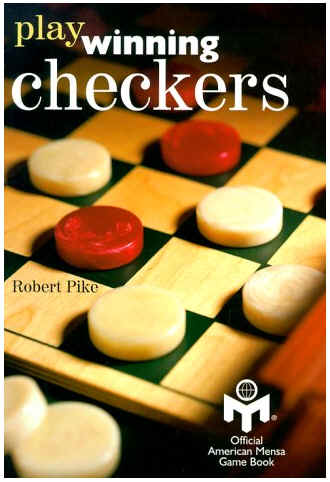
The checkers in the photo could possibly be "catalin" which is a bakelite-like material. Light color swirls are present in these pieces also. "Catalin" checkers are apparently no longer manufactured. For some reason they have become collectibles and run upwards of $125 per set.
The Catalin checkers appear thinner than the Crisloids. (I don't know anything about the wooden board in the photo, but doesn't it look like finished and painted plywood?)
Finally there are 1 3/8" diameter, 1/4" thick solid color Danish checkers (photo at the beginning of this article; better photos to come). These seem to match pretty closely with some tournament photos I've found around the Web. They are clearly regulation, even if a bit thin.
Crisloid checkers can also be obtained from Backgammon A La Carte, where they are available in three sizes at much more attractive prices ($34 with shipping for the 1 1/2 " size and $24 for the 1 1/4 " size):
http://www.flintbg.com/boutique.html
This is run by Carol Joy Cole, a backgammon enthusiast, and a nicer vendor you will not find. Carol also sells the solid color, 1/4" thick and 1 3/8" wide pieces from Denmark, which at $15 represent a great bargain.
Carol also has obtained a stock of solid color non-swirly Crisloids, in both 1 1/2" and 1 1/4" sizes. This was a limited production run and I can't say if future availability will be an issue; it may in fact be a problem. They sell for a few dollars more than the swirly-colored Crisloids and are really worth it.
There are two possible objections to the 1 1/2" Crisloids: the color swirls in the non-solid-color pieces (white within red and clear within white), and the thickness of the pieces.
With a 1 1/2 " width and a 7/16 " height, the width to height ratio is 3.43. Our old favorite flimsy plastic pieces, by comparison, have a 5.00 ratio. I actually like the heft and substantial feel of the Crisloids; when you make a move it feels authoritative, and a king really looks like a king.
The color swirls, on the other hand, are distracting, and I would have to recommend the solid color pieces as a first choice instead.
The 1 1/4" Crisloids are 3/8" thick, just like the concentric circle pieces, but they appear thicker because they are smooth and solid. Although they have the virtually same width to height ratio of the various other pieces, they somehow feel proportionately a little thinner. The color swirls in these pieces are much more obvious and distracting than in the larger Crisloids, but again, get the solid-color variety as a clear first choice.
The 1 3/8" Danish solid color checkers are 1/4" thick. These are very nice checkers and work well on both the 1 7/8" square and the 2" square boards. The width to height ratio is 5.5, the highest of any set I've used, and so the pieces appear thin, and a king isn't all that kingly. Yet these checkers are a good match for the recommended boards, don't have distracting swirls, and are economical ($15 plus shipping).
3.3. Boards
3.3.1 US Sources
Let's now look at obtaining just the regulation two-inch squared board. There are a lot of very nice vinyl green and buff boards sold as chessboards. However, the tournament standard for chessboards is 2 1/4 " squares, making for an 18" playing surface, a bit larger than the 16 " regulation" checker surface. This larger size board, though slightly out of spec, works very well with large checkers, and is easily available without distracting algebraic notation on the edges (photo to follow). (Note: American Pool Checkers uses this size of board in tournaments, but that's somewhat off-topic.)
In addition, I did find a "medium" size vinyl board with 1 7/8" squares:
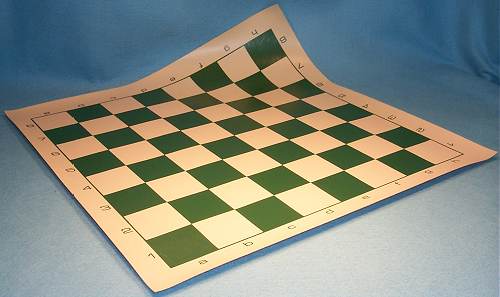
This makes for a 15 " playing surface which I think comes close enough to being acceptable even for tournament play. The board does have the distracting algebraic chessboard notation on it, but I don't think this is a fatal flaw. The board is very inexpensive, around $6 plus shipping, and can be obtained from Your Move Chess And Games: http://www.chessusa.com .
(The larger board can also be obtained from them for about $8.)
There are many other boards out there but these seemed by far the closest match at an economical cost, although they are not strictly regulation.
I received my order from Your Move Chess and Games in about eight days, of which seven days was UPS shipping time. The order was exactly as expected and I have to rate this vendor as responsive and customer focused, and someone I would gladly order from again.
The vinyl board with 1 7/8 " squares is convenient and nice. The green color of the green squares is a really dark green; a touch lighter would have been a little better, I think. The algebraic chess notation markings around the edge are large and at first annoying but are very quickly ignored. I like the ability to roll up the board, fasten with just a rubber band for transport, and have it lay out virtually flat when unrolled. The playing surface has a nice feel and the underside grips the table and prevents slipping. This is such a value for six dollars it is just short of incredible.
The 1 1/4" "concentric circle" checkers shown in the picture above are 3/8" in thickness and have a width to height ratio of something like 3.3. When placed on the 1 7/8" squares they have a lot of room to breathe; and in my view they appear a little lost. But they are pure red, even if they are not smooth and flat. They are thick enough to have a substantial feel, but they are not as thick and hefty as the large Crisloids. And they are not quite regulation.
Going back and putting the 1 1/2" Crisloids on the same board, though, yields an elegance of appearance that I really appreciate. To me, this is what tournament checker sets ought to be. (Remember I have yet to play in a checkers tournament! I'm just comparing this with the overall "feel" I got playing in chess tournaments.) The color swirls are a bit annoying, as is the algebraic notation, but only a bit, and when you look at the total playing environment, the effect is pleasing. The pieces are substantial and fill the squares nicely (although I can't help but think that the tiny bit of extra room on 2 inch squares are the finishing touch).
All that said, the 1 1/2" checkers really are best on a slightly off-spec board with 2 1/4" squares. But the fit is great, and there is a roomy expansiveness about this combination.
A helpful reader pointed me to Chesscafe for near-regulation 1 7/8" linen folding boards which don't have distracting algbraic notation. These are about $23 plus shipping at Chesscafe ( http://www.chesscafe.com ). Chesscafe also has nice-looking vinyl and wooden boards.
But if you'd like to go upscale, I found some wooden boards with exact two-inch squares. One of them is made of birdseye maple and looks like this:
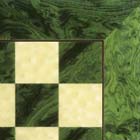
As you can see, alternating squares of maple are stained green, and there is a green border. This looks to be an elegant board, correctly sized, and of just about the right colors, although the green border runs into the green squares at the edge--- it could just be a bit too green for some tastes. However, it's minus the algebraic notation indicators of the vinyl boards. The maple board is $74 plus shipping from The Chess Shop in New York, so this is definitely a more upscale purchase. However I couldn't resist ordering one.
I received the elegant maple wooden board described above in about 11 days. The Chess Shop took about four days from the time of order to get it shipped, which seems a tiny bit long, and then there was seven days UPS time. However, the board was packed with the utmost care and arrived absolutely pristine.
This is a really fine board, with a very hard finish over the wood that makes it feel almost like stone. It sits on our coffee table with grace and style. I only have two minor objections: the hard finish seems susceptible to small scratches, and the smooth bottom doesn't 'grip' the table to stay in place.
An interesting thing happens when you combine this board with the swirled-color 1 1/2" Crisloid pieces (described below). The grain of the wood acts as a foil for the swirled colors and the total effect is very nice, if slightly less than regulation. (But I still recommend the solid color Crisloids.)
Another source of a wide variety of wooden boards is House of Staunton at http://www.houseofstaunton.com ; these are, however, all near-regulation boards with 1 7/8" squares.
3.3.2 UK Sources
A very helpful correspondent pointed me to a bonanza of regulation equipment obtainable from Chess Direct in the UK. There are three offerings of interest, all of which have regulation two inch squares and green and buff colors!
First, there is the folding board:
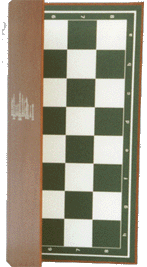
Next, the vinyl board:
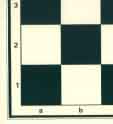
Finally, there is a "semi-rigid" plastic board:
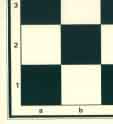
These will cost you about $6-$20 each (the vinyl being the least expensive and the folding board the most) plus shipping from the UK.
3.3 Making Your Own Sets
One thing I do wish to pursue further is the idea of making your own equipment. One clever correspondent said, for instance, that he bought sheets of vinyl material, cut out the appropriately sized squares, and glued this to masonite. That sounds like a relatively inexpensive way to have a utilitarian board. But no doubt there are woodworkers who could explain how to make a stained, inlaid board, and nice pieces; if you can help, please write!
I have been told that someone on E-Bay once sold home-made regulation boards made out of ceramic materials. I located and contacted this source but never heard back. The idea seemed rather clever; glue green and buff two inch ceramic tiles to something like 3/4 " plywood. Perhaps someone might like to try this out?
4. Results to Date.
Here are a few photos of some of the various checker sets that I've assembled in the quest for the "real thing." This could use an update; the color balance is off; some newer options are omitted; and some obsolete options are included.)
4.5 Conclusions
Here are my bottom line conclusions at the moment.
The only really "regulation" pieces easily obtained at the moment are the Danish ones from Backgammon A La Carte and the solid color Crisloids from the same source (long-term availability unknown). You can get near-regulation substitues of various types without much difficulty and you may find them perfectly satisfactory.
There are nice, fully regulation wooden boards and folding boards available from various US and UK sources. If you are willing to go slightly off-spec, vinyl boards are a very inexpensive alternative
The 1 1/2" Crisloids on a 1 7/8" square vinyl board are elegant and attractive and seem suitable for tournament play, but are not strictly regulation. If you feel the board is a bit crowded you can use the 1 3/8" Danish pieces, and get a little closer to regulation.
The 1 1/2" solid color Crisloids on the 2" birds-eye maple board (or other 2" boards) look very nice and are fully regulation. The Danish pieces on this board also make a fully regulation combination.
The 1 1/4" "concentric circle" checkers might best be used on a smaller board for study or casual play (Your Move Chess And Games has a "small" vinyl board which I also ordered and is just about perfect for study purposes). Of course this is not (and doesn't pretend to be) regulation.
You save a lot of money by buying checkers from Backgammon A La Carte and boards from Your Move Chess And Games, and given the ease of on-line ordering, splitting your order is not very much trouble. But if you want the ultimate bargain, order from the International Checker Hall of Fame.
In my search for the grail of regulation equipment, I consulted many photos of checker players "in action." I believe from this that tournament checkers generally is played with pieces with a slighty thinner look than the Crisloids. So, the Danish pieces may be preferred by some players.
5. Can You Help?
If anyone has an alternate source of supply, or a source of more "exact" items, I would love to hear from you! Please mail bobnewell@bobnewell.net .
6. Analysis: What Size Pieces?
6.1 A Little Theory
The bottom line is that I recommend 1 1/2 " pieces for a board with 1 7/8 " or 2" squares. My taste is more toward fullness; your taste may differ. Some experts disagree and feel that 1 1/2" pieces are definitely too large.
The determinant of how a piece looks on a square seems to be (at least to me) how much of the square the piece fills. Too much fill, and the board looks crowded; too little fill, and the board looks bare.
Let's consider the "official" board with 2 " squares. A 1 1/4 " piece fills 30.7% of the square, while a 1 1/2 " piece fills 44.2% of the square. If you buy the 1 7/8 " squared board mentioned above, a 1 1/4 " piece fills 34.9% of the square while a 1 1/2 " piece fills 50.3% of the square. Either one looks good enough to my eye; if you want a leaner look go for the 1 1/4 " and a fuller look go for the 1 1/2". (The picture from Robert Pike's book above seems to have pieces which rather over-fill the squares; I'd eyeball that at 70% fill.) Note that our old black and red sets gave us about 54.5% fill; actually somewhat higher if you take out the yellow lines; and 1 1/2" pieces on 1 1/2" squares, a situation of maximum "fullness," gives about 78.5% fill and looks terrible.
6.2 A Little History
Now here is an interesting historical perspective, which may or may not be definitive. In his book on Scientific Checkers, Newell W. Banks advertises a certain brand of board and set. The board is listed as green and buff, with 1 15/16 " squares, so close to 2 " that the difference probably doesn't matter. (The over-all board would be 1/2 " shorter than a board with 2 " squares.) He claims that this board is perfectly sized for "standard" 1 1/4" pieces. Does this mean that considerably less square fill was then viewed as desirable? That would appear to be the case, as the specified dimensions yield 31.8% fill. Thickness of the pieces was not mentioned.
Further evidence for spare appearance can be adduced from earlier codes of rules. These called for boards from 14 1/2 " to 16 " (1.81 " to 2 " squares) and pieces from 1 1/8 " to 1 1/4 " in diameter. As the current rules specify 2 " squares and pieces from 1 1/4 " to 1 1/2 " in diameter, does this mean that tastes have shifted away from a spare look to a more full look? I do hope that a checkers veteran who knows the answer will write to me and clarify this question.
7. Conclusion.
So there you have it. A decent checkers set of regulation or near-regulation specifications, can be had for under $50 with options as low as $5. Elegant sets can be had for under $125. How much time do you spend playing checkers? To me a really nice set for home use is a worthy investment. For club or tournament use, a workable set can be provided for the cost of one player's tournament entry fee.
8. Other Comments and Other Sets.
You can get wooden checker pieces a few places, although not in regulation red and white that I am aware of. However, if you hang around on E-Bay or similar sources, sometimes you come across a few things. A while ago I got some old wooden checkers in a variety of sizes and colors. There were enough to make up a full set of reds and whites (actually natural light wood color). I dutifully dirtied a towel washing them up (the red paint runs a little on those old "Comets") and then tried them out, thinking that this would be a great checker experience with "regulation" wooden pieces.
What a surprising disappointment. After playing with the smooth plastic Crisloids, by comparison the old wooden checkers seemed dull in color and insubstantial in feel. The Crisloids came back out and the wooden checkers went back in their bag within fifteen minutes.
I have dealt here only with my search for regulation checkers equipment. If you look around the internet, in fact you can find some absolutely beautiful boards, pieces, and sets. But they are not regulation and therefore are not properly the subject of this article.
9. A Brief Lament
Nice checker sets of a regulation or near regulation nature are, as I pointed out way back at the beginning of this article, not all that easy to find. With the exception of the International Checker Hall of Fame's $5 set, they are also relatively expensive. Otherwise, the least costly option presented here is a $6 vinyl board and a $15 set of checkers. This makes for a good set for $21, which is only slightly short of regulation.
But chess sets of high quality are so much easier to find and generally so much less expensive. A basic "tournament" set with a 2 1/4" square vinyl board and a really decent set of plastic pieces, perfectly sized and proportioned for the board, can be had for $10 or less.
It just doesn't seem fair. Has checkers equipment truly fallen to the toy store level? Hopefully some day checkers will regain popularity, and this situation will change.
10. Contact.
I would be very pleased to hear from you.
Please mail bobnewell@bobnewell.net with any comments or suggestions about this page.
The contents of this page will change as I discover new sources and gather experience with the merchants and the products.
Disclaimer.
Here is the legal stuff: I do not represent any of the vendors, people, or organizations listed here and I do not specifically endorse or warranty their products. You must make your own determination of the suitability of any such products.